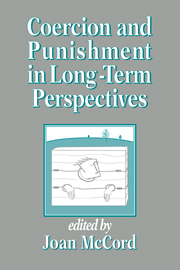Book contents
- Frontmatter
- Contents
- List of contributors
- Acknowledgments
- 1 Introduction: coercion and punishment in the fabric of social relations
- I Mental health, coercion, and punishment
- II Family socialization practices and antisocial behavior
- III Aggression and coercion in the schools
- 11 The impact of peer relationships on aggression in childhood: inhibition through coercion or promotion through peer support
- 12 Classroom seating and juvenile delinquency
- 13 Social skills training and aggression in the peer group
- 14 Early adolescent social influences on delinquent behavior
- IV Deviance, crime, and discipline
- V Measuring and predicting in studies of coercion and punishment
- Name index
- Subject index
11 - The impact of peer relationships on aggression in childhood: inhibition through coercion or promotion through peer support
Published online by Cambridge University Press: 29 September 2009
- Frontmatter
- Contents
- List of contributors
- Acknowledgments
- 1 Introduction: coercion and punishment in the fabric of social relations
- I Mental health, coercion, and punishment
- II Family socialization practices and antisocial behavior
- III Aggression and coercion in the schools
- 11 The impact of peer relationships on aggression in childhood: inhibition through coercion or promotion through peer support
- 12 Classroom seating and juvenile delinquency
- 13 Social skills training and aggression in the peer group
- 14 Early adolescent social influences on delinquent behavior
- IV Deviance, crime, and discipline
- V Measuring and predicting in studies of coercion and punishment
- Name index
- Subject index
Summary
According to Patterson, Reid, and Dishion (1992), aversive interactional patterns within the family provide for the early training of young boys' aggression and antisocial behavior. The coercive family process refers to a pattern of reciprocal exchanges in which poor family management practices such as inconsistent and ineffective parental responses are coupled with the child's persistent aversive behavior. The typical pattern is one of escalation and negative reinforcements. The coercion process usually starts with an exchange of often trivial, innocuous responses between a parent and a child. It quickly degenerates as the two actors are prompted to accentuate the punitive aspect of their behavior so as to control or coerce the other. When one actor gives in (usually the parent), this cyclical pattern is terminated by the removal of the aversive stimuli (i.e., the child's aversive behavior), thus negatively reinforcing such behaviors. Hence, by this coercive process the child is likely to learn quickly to become the initiator and the victim of aggressive behavior while training his or her parents to use highly punitive strategies. Coercive family processes may originate from a combination of factors such as a difficult child, the lack of parental competence, and an exposure to environmental stressors, but the crucial point is that they are exacerbated by a process of negative reciprocal exchange and bolstered by intermittent negative reinforcements.
- Type
- Chapter
- Information
- Coercion and Punishment in Long-Term Perspectives , pp. 183 - 197Publisher: Cambridge University PressPrint publication year: 1995
- 42
- Cited by

